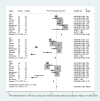Decomposition and Spatio-temporal analysis of health care access challenges among reproductive age women in Ethiopia, 2005-2016
- PMID: 32807148
- PMCID: PMC7433138
- DOI: 10.1186/s12913-020-05639-y
Decomposition and Spatio-temporal analysis of health care access challenges among reproductive age women in Ethiopia, 2005-2016
Abstract
Background: The high maternal mortality, home delivery, unwanted pregnancies, incidence of unsafe abortion, and unmeet family planning needs are maternal health gaps attributed to health care access barriers and responsible for the observed health care disparities. Over the last decades remarkable achievements have made in relation to maternal health problems and the reduction of health care access barriers. Thus, this study aimed to assess the decomposition and spatial-temporal analysis of health care access challenges among reproductive-age women in Ethiopia.
Methods: Secondary data analysis was conducted based on the three consecutive Ethiopian Demographic and Health Surveys (2005-2016 EDHSs). A total weighted sample of 46,235 reproductive-age women was included in this study. A logit based multivariate decomposition analysis was employed for identifying factors contributing to the overall decrease in health care access challenges over time. For the spatial analysis, ArcGIS version 10.6 and SaTScan™ version 9.6 were used to explore hotspot areas of health care access challenges in Ethiopia over time. Variables with p-value < 5% in the multivariable Logit based multivariate decomposition analysis were considered as significantly contributed predictors for the decrease in health care access challenges over time.
Result: The mean age of the women was 27.8(±9.4) years in 2005, 27.7(±9.2) years in 2011, and 27.9 (±9.1) years in 2016. Health care access challenges have been significantly decreased from 96% in 2005 to 70% in 2016 with the Annual Rate of Reduction (ARR) of 2.7%. In the decomposition analysis, about 85.2% of the overall decrease in health care access challenge was due to the difference in coefficient and 14.8% were due to differences in the composition of the women (endowment) across the surveys. Socio-demographic characteristics (age, residence, level of education, female household head, better wealth and media exposure) and service utilization history before the survey (facility delivery and had ANC follow up) contribute to the observed decrease over time. The spatial analysis revealed that health care access challenges were significantly varied across the country over time. The SaTScan analysis identified significant hotspot areas of health care access challenges in the southern, eastern, and western parts of Ethiopia consistently over the surveys.
Conclusion: Perceived health care access challenges have shown a remarkable decrease over time but there was variation in barriers to health care access across Ethiopia. Media exposure improved mothers' health care access in Ethiopia. Public health programs targeting rural, uneducated, unemployed, and women whose husband had no education would be helpful to alleviate health care access problems in Ethiopia. Besides, improving mother's media exposure plays a significant role to improve mothers' health care access. Health care access challenges have significantly varied across the country. This suggests that further public health interventions are important for further reduction of health care access barriers through the uplifting socio-demographic and economic status of the population.
Keywords: Ethiopia; Health care access challenge; Multivariate decomposition analysis; Spatio-temporal analysis.
Conflict of interest statement
Authors declare that they have no conflict of interest.
Figures














Similar articles
-
Trends and Spatio-temporal variation of female genital mutilation among reproductive-age women in Ethiopia: a Spatio-temporal and multivariate decomposition analysis of Ethiopian demographic and health surveys.BMC Public Health. 2020 May 19;20(1):719. doi: 10.1186/s12889-020-08882-4. BMC Public Health. 2020. PMID: 32493430 Free PMC article.
-
Spatial distribution and determinants of the change in pre-lacteal feeding practice over time in Ethiopia: A spatial and multivariate decomposition analysis.PLoS One. 2021 Jan 14;16(1):e0244574. doi: 10.1371/journal.pone.0244574. eCollection 2021. PLoS One. 2021. PMID: 33444391 Free PMC article.
-
Trend change in delayed first antenatal care visit among reproductive-aged women in Ethiopia: multivariate decomposition analysis.Reprod Health. 2022 Mar 28;19(1):80. doi: 10.1186/s12978-022-01373-2. Reprod Health. 2022. PMID: 35346248 Free PMC article.
-
Trends and contributors of complete continuum of maternal healthcare service utilization in Ethiopia: a multivariate decomposition analyses.Reprod Health. 2025 Jan 27;22(1):9. doi: 10.1186/s12978-025-01945-y. Reprod Health. 2025. PMID: 39871354 Free PMC article.
-
Challenges of 20th century Ethiopian Science education.Heliyon. 2021 May 28;7(6):e07157. doi: 10.1016/j.heliyon.2021.e07157. eCollection 2021 Jun. Heliyon. 2021. PMID: 34169160 Free PMC article. Review.
Cited by
-
Rural-urban disparity in community-based health insurance enrollment in Ethiopia: a multivariate decomposition analysis using Ethiopian Mini Demographic Health Survey 2019.Front Public Health. 2024 Jul 29;12:1361793. doi: 10.3389/fpubh.2024.1361793. eCollection 2024. Front Public Health. 2024. PMID: 39145179 Free PMC article.
-
Individual-level and community-level determinants of the number of antenatal care visits in emerging regions of Ethiopia: a negative binomial model.BMJ Open. 2025 Jul 16;15(7):e086571. doi: 10.1136/bmjopen-2024-086571. BMJ Open. 2025. PMID: 40669919 Free PMC article.
-
Trends, spatiotemporal variation and decomposition analysis of pregnancy termination among women of reproductive age in Ethiopia: Evidence from the Ethiopian demographic and health survey, from 2000 to 2016.Heliyon. 2024 Jul 14;10(14):e34633. doi: 10.1016/j.heliyon.2024.e34633. eCollection 2024 Jul 30. Heliyon. 2024. PMID: 39130402 Free PMC article.
-
Spatial distribution of teenage pregnancy and its associated factors in Ethiopia: spatial and multilevel analysis of EDHS 2019.Arch Public Health. 2024 Sep 26;82(1):165. doi: 10.1186/s13690-024-01380-8. Arch Public Health. 2024. PMID: 39327596 Free PMC article.
-
Problems with accessing healthcare and associated factors among reproductive-aged women in the Gambia using Gambia Demographic and Health Survey 2019/2020: a cross-sectional study.BMJ Open. 2023 Aug 2;13(8):e073491. doi: 10.1136/bmjopen-2023-073491. BMJ Open. 2023. PMID: 37532481 Free PMC article.
References
-
- Blaauw D, Penn-Kekana L. Maternal health: reflections on the millennium development goals. S Afr Health Rev. 2010;2010(1):3–28.
-
- Bloom G, Katsuma Y, Rao KD, Makimoto S, Leung GM. 2030 AGENDA FOR SUSTAINABLE DEVELOPMENT Deliberate Next Steps toward a New Globalism for Universal Health Coverage (UHC).
-
- Organization, W.H . Monitoring health for the SDGs: sustainable development goals. Geneva: World Health Organization; 2016.
MeSH terms
LinkOut - more resources
Full Text Sources

